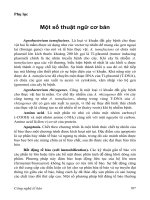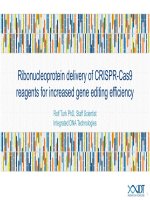công nghệ nano_Nanopracticical
Bạn đang xem bản rút gọn của tài liệu. Xem và tải ngay bản đầy đủ của tài liệu tại đây (7.95 MB, 35 trang )
Ribonucleoprotein delivery of CRISPR-Cas9
reagents for increased gene editing efficiency
Rolf Turk PhD, Staff Scientist
Integrated DNA Technologies
1
Outline—Alt-R™ CRISPR-Cas9 System
• Ribonucleoprotein complex (RNP)
– Generation of RNP complex
– Stability of RNP complex
– Editing efficiency of RNP
• Cas9 electroporation enhancer
– Increases editing efficiency
• RNP delivery using the Amaxa® Nucleofector® System (Lonza)
– Optimization
• RNP delivery using the Neon® System (Thermo Fisher)
– Optimization
2
CRISPR genome editing
CRISPR guide RNAs
DNA incorporation or
gene knockout
• Homology-directed repair—add or
replace gene sequences
• Non-homologous end joining—
destroy a gene
Cas9 protein
RNA-directed dsDNA
endonuclease
3
Implementing CRISPR-Cas9 gene editing
4
CRISPR-Cas9 products from IDT
5
3-step transfection using Alt-R™ CRISPR-Cas9
System
Step 1
Step 2
Step 3
+
+
gRNA complex formation
RNP complex formation
RNP delivery
15 minutes
10–20 minutes
30–60 minutes
6
Cas9 protein is rapidly degraded—fewer off-target
effects
Western blot
Off-target indel production
Liang X, Potter J, et al. (2015) Rapid and highly efficient mammalian cell
engineering via Cas9 protein transfection. J Biotechnol, 208:44–53.
7
Benefits of RNP: Cas9 protein rapidly degraded,
fewer OTEs
RNP, HEK-293 cells
Nucleofection, EMX1 targeting gRNA, 48h
50
45
40
35
30
25
20
15
10
5
0
T7EI cleavage (%)
T7EI cleavage (%)
HEK-293–Cas9 cells
Nucleofection, EMX1 targeting gRNA, 48h
0.1 µM
0.3 µM
On target
1 µM
3 µM
Off target
50
45
40
35
30
25
20
15
10
5
0
0.1 µM
0.3 µM
On target
1.0 µM
5.0 µM
10 µM
Off target
• Sustained expression of Cas9 allows for OTEs. Even lowexpression HEK-293–Cas9 cells allow for off target editing.
• RNP is “fast on and fast off,” and has fewer OTEs
8
Ribonucleoprotein ease of use—highly stable
Cas9 system
T7EIcleavage(%)
5monthRNPcomplexstability—RNPstoredat[1µM]
HEK293cells,10nM RNP(1.2µL),RNAiMAX(1.2µL), 48hr
100
90
80
70
60
50
40
30
20
10
0
HPRT site 1
Fresh
Complex
–80°C
–20°C
HPRT site 2
4°C
Cas9Buffer
Fresh
Complex
OptiMEM
–80°C
–20°C
4°C
PBS
• Loss in activity seen at –20°C (likely due to freeze–thaws)
• Premade complexes are stable at 4°C and –80°C with no loss in activity
9
CRISPR workflow
Lipofection
Easier to transfect cells
Design
gRNAs
Assemble
RNP
Electroporation
Harder to transfect cells,
primary cells
Microinjection
Mouse model generation
and other research
organisms
Collect
genomic
DNA
Analyze
10
Delivery of RNP by electroporation
Amaxa® Nucleofector® (Lonza)
Neon® Transfection System (Thermo Fisher)
• 1-, 16-, or 96-well format
• Online database
• Single cuvette
• Online database
– Cell lines
– Primary cells
• Expensive
• Electroporation parameters
unknown à hard to optimize
– Cell lines
• Known parameters
• Easy optimization
• Expensive
11
12
Considerations when doing electroporation
• Requires higher ribonucleoprotein concentrations [2–4 µM] compared to
lipofection
• Cas9 ribonucleoprotein complex is not encapsulated
– More accessible to nucleases
– More accessible to proteinases
• Electroporation parameters differ per cell line
– Amaxa Nucleofector
• Cell database
• Optimization protocol (96-well format)
– Neon Transfection System
• Optimization protocols
13
Optimization strategy for electroporation
• Find optimal electroporation parameters
– Nucleofector System: Electroporation program
– Neon Transfection System: Voltage, pulse width, number of pulses
• Pay close attention to cell viability
– Use cells with low passage numbers
– Use appropriate cell density (should be sub-confluent)
•
•
•
•
Follow recommendations from IDT user guides and protocols
If necessary, test a range of RNP concentrations
Include positive and negative controls
Use Cas9 electroporation enhancer to boost editing efficiency
14
Electroporation—verify reagents free of RNases
T7EIcleavage(%)
Electroporation—optimaldissociationmethod
Alt-R™CRISPRcrRNA[4µM]—HEK293Cas9Cells
100
90
80
70
60
50
40
30
20
10
0
EMEM
EMEM+FBS
No PBS wash
•
•
Non-enzymatic cell
dissociation solution
Trypsin
EMEM
EMEM+FBS
PBS wash
EMEM
EMEM+FBS
No PBS wash
EMEM
EMEM+FBS
Cell dissociation
method
Cell resuspension
media
PBS wash
Testing shows that commercially purchased trypsin contains RNases
RNaseAlert® Assay (IDT)
15
Electroporation enhancer DNA improves gene
editing efficiency
• Use of electroporation enhancer DNA improves outcome in RNP
electroporation
• Effect varies with cell type and electroporation protocol
(Nucleofector > Neon)
16
Cas9 electroporation enhancer
• IDT custom Ultramer® Oligonucleotide; available at
www.idtdna.com/ultramer
• Sequence:
TTAGCTCTGTTTACGTCCCAGCGGGCATGAGAGTAACAAGAGGGTGTGGT
AATATTACGGTACCGAGCACTATCGATACAATATGTGTCATACGGACACG (100 nt)
• Note: This oligo does not have significant homology to the human, mouse,
or rat genomes, and has been tested as carrier DNA in multiple human cell
lines, including HEK-293, Jurkat, and K562.
• Before use in other species, verify that this oligo does not have similarity to
your host cell genome to limit participation of the oligo in the doublestranded DNA break repair process.
17
RNP Nucleofection—effect of electroporation
enhancer
T7EItotaleditingefficiency(%)
35
Cas9 RNP, HEK-293
30
25
3.3 µM RNP
30 µL volume
= 100 pmol (16 µg)
20
15
10
5
0
0 µM
No
Carrier
1 µM
4 µM 10 µM 1 µM
4 µM 10 µM 1 µM
20 nt
95 nt
4 µM 10 µM 1 µM
200 nt
4 µM 10 µM
tRNA
18
Positive and negative controls
19
20
T7EItotaleditingefficiency(%)
Nucleofection—RNPdilutionseries—HEK-293cells
TheeffectofcarrierDNAandsequenceoneditingefficiency
Conditions:
•
•
•
•
•
•
100
90
80
70
60
50
40
30
20
10
0
•
•
•
0.0
0.5
1.0
1.5
2.0
2.5
3.0
3.5
4.0
Ribonucleoproteincomplexconcentration(µM)
4µMelectroporationenhancer
Noelectroporationenhancer
4.5
•
•
•
Amaxa Nucleofection
Nucleofection Solution SF
Protocol 96-DS-150
2 x 105 cells/Nucleofection
HPRT locus: 38285
crRNA:tracrRNA:Cas9 =
1.2:1.2:1
RNP concentrations,
0.125–4 µM
Electroporation enhancer DNA,
4 µM
48 hr incubation, following
Nucleofection
3X genomic DNA dilution
Digest with T7EI, 2 U
Fragment Analyzer™
(Advanced Analytical
Technologies)
21
T7EItotaleditingefficiency(%)
Nucleofection—RNPdilutionseries—Jurkatcells
TheeffectofcarrierDNAandsequenceoneditingefficiency
Conditions:
•
•
•
•
•
•
100
90
80
70
60
50
40
30
20
10
0
•
•
•
0
0.5
1
1.5
2
2.5
3
3.5
4
Ribonucleoproteincomplexconcentration(µM)
4µMelectroporationenhancer
Noelectroporationenhancer
4.5
•
•
•
Amaxa Nucleofection
Nucleofection Solution SE
Protocol 96-CL-120
5 x 105 cells/Nucleofection
HPRT locus: 38285
crRNA:tracrRNA:Cas9 =
1.2:1.2:1
RNP concentrations,
0.125–4 µM
Electroporation enhancer DNA,
4 µM
48 hr incubation, following
Nucleofection
3X genomic DNA dilution
Digest with T7EI, 2 U
Fragment Analyzer™
(Advanced Analytical Technologies)
22
T7EItotaleditingefficiency(%)
Nucleofection—RNPdilutionseries—K562cells
TheeffectofcarrierDNAandsequenceoneditingefficiency
Conditions:
•
•
•
•
•
•
100
90
80
70
60
50
40
30
20
10
0
•
•
•
0.0
0.5
1.0
1.5
2.0
2.5
3.0
3.5
4.0
Ribonucleoproteincomplexconcentration(µM)
4µMelectroporationenhancer
Noelectroporationenhancer
4.5
•
•
•
Amaxa Nucleofection
Nucleofection Solution SF
96-FF-120 protocol
5 x 105 cells/Nucleofection
HPRT locus – 38285
crRNA:tracrRNA:Cas9 =
1.2:1.2:1
RNP concentrations,
0.125–4 µM
Electroporation enhancer DNA,
4 µM
48 hr incubation, following
Nucleofection
3X genomic DNA dilution
Digest with T7EI, 2 U
Fragment Analyzer™
(Advanced Analytical
Technologies)
23
24
Workflow
•
•
•
•
•
•
HEK-293 cells: 1 x 105 cells per electroporation
HPRT 38285
RNP—crRNA:tracrRNA:Cas9 = 1.8:1.8:1.5 µM
12 µL volume (10 µL electroporated)
Electroporation enhancer, 1.8 µM
24 different protocols
– Voltage
– Pulse width
– Pulse length
• gDNA isolation 48 hr after electroporation
• T7EI assay
25




